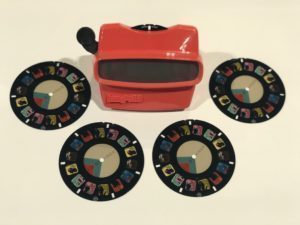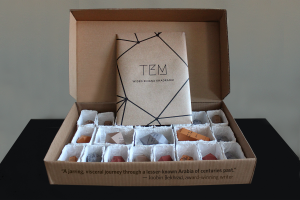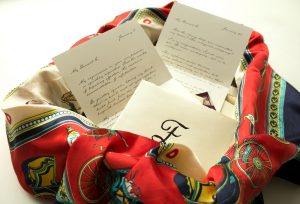
Doug Luman and Jenni B. Baker’s Container is a literary project for artists interested in nontraditional storytelling. Container tells stories on lunchboxes and Rolodexes, on View Masters and with textiles—artists aren’t confined to book form. Recently we got the chance to talk about their vision, their story-objects, and whether or not a flower pot can be a poem.
SLQ: What first drew you to alternative methods of storytelling?
DOUG: I think that we’ve both been interested for quite a while in the “fringe” ways that stories and poems can be told or composed. Originally, Jenni and I (with a few others) worked on the journal The Found Poetry Review (FPR), which brought together a community of writers who were also interested in alternative approaches to process and product. Our various projects and publications often featured challenges that required writers to compose from limited or prescriptive means (such as using only dialog heard while out and about during the day, or plundered from Pulitzer prize-winning novels, to name a couple of examples).
These approaches were not new. Influence sometimes works in direct and powerful ways. We took our cue from writers like Georges Perec and Raymond Queneau (really, the Oulipo at large) as well as a host of others. And, after a few years, we found fellow poets we’d gathered along the way publishing books and placing their work in more commonplaces of the literary mainstream (“mainstream” insofar as poetry goes). While still interested in these methods, our interest grew and adapted from there.
Jenni and I were both involved in different material projects in 2016-17, and this way of making appealed to us with our history of the “nontraditional” powering the way we approached creating literary objects. In fact, it felt more like a kind of expression that as closer to home than a two-dimensional engagement with language. Often, we’d look at an object like a flower pot, and think “how can that be a poem”?
FPR was still an active project, but we found that the community around that publication had achieved a kind of unspoken goal: to popularize unconventional writing methods. With that in mind, after both of our experiences working with object-based projects, we felt that it was time to turn our energy toward promoting and engaging with this new form of literary making.
SLQ: What are your favorite hybrid literary/art pieces you’ve published at Container?

DOUG: We pick every project because there’s something that we love about it. We’ve been fortunate that our reading periods have always produced so much great work that we’ve found purchase in.
Wided Khadraoui’s Tem (our first project) spoke to us because it engaged in traditions that we found incredibly interesting and necessary. The author’s concept (the gem tray object) appealed to us because it gave a reader/viewer so much interact and work with. The process of making the editions was just as appealing. I can’t say that our level of delight and enjoyment of the building process doesn’t factor into what we love, and Tem was a kind of maker’s dream.
E,UIO,A (Dave Drayton) began as a text whose conceit we loved: an Oulipean book in physical form. The text spoke to Jenni and my history as writers and the challenge of making the full correspondence (individual letters and all) appeared to us like it was tailor-made for us. Some of the most impactful art can be expressions of things that you already know or hold dear. And, in this case, we were able to merge our literary past and our present in editing and making this text.
I’d be remiss if I didn’t also say how much we love our Multitudes projects. We relish the opportunity to work with poets and artists whose work we admire, for some of whom their invitation to the project is their first engagement with making object-oriented work. Often, we’ve heard from the participants that thinking about writing in this new form jump-started some other dormant or unconceived project. It’s been amazing to hear from artists about how their involvement creates new pathways either toward more object-based work or in their current practices.
SLQ: Why do you think Container’s publishing vision is especially relevant today?
DOUG: There’s a direct link from this kind of production to the legacy of the “maker” movement (if it’s fair to write “legacy” of an ongoing trend). More people are simply making more “stuff.” Often, we see this in videos from ComicCon or other similar events where fans go to great lengths to reproduce costumes, props, and every manner of object from their favorite fictional universes. At a basic level, these folks are really saying “I love this find meaning in it.” I don’t think that’s very far from how Jenni and I feel about writing, literature, and the objects what we publish.
Of course, “maker” culture extends into the Kickstarter world where new products find their way to market due to lower costs and greater access to technology. People are 3D printing replacement parts to repair objects that they own or, in many cases, are reviving interest in woodworking or discovering circuitry. Recently, Jenni and I were in a sewing workshop, and one of the other participants was ecstatic about the possibility that he could patch his own clothes. Interest in materials arts is taking off again, even if the purpose is directed toward more practical ends.
We certainly see a benefit from this. We’re in a moment like that of the “Arts and Crafts” movement of the late 19th/early 20th century. I don’t think that the influence of that time ever went away, and the resurgence interest in “making” cements it as a cultural fixture once again.
When we sunset FPR to pursue Container, we did it with a few goals in mind: one being that we hope to promote object-based text collaborations between ourselves and the writers we work with. Perhaps more importantly, we’re interested in furthering interest in the craft of the book object. Jenni and my entrance to this world was marked by nothing more than just that: intense interest; so far, we’ve learned skills and methods along the way. Container’s message is really that anyone can do this if they have a strong idea and are willing to stick through making tons of bad prototypes.

SLQ: What advice would you give to writer/artists who are looking to create hybrid work?
JENNI: Generating ideas for new work in a space where anything is possible can be counterintuitively difficult. Given that reality, it’s important to make space for divergent and convergent thinking when developing a project idea.
One of my favorite divergent thinking activities from the design thinking world is the “wall of 100 ideas” exercise. With a stack of post-its and a marker in hand, you endeavor to generate at least 100 ideas (one per post-it) in the span of an hour. You’re not pausing to evaluate whether the idea is good or not, or whether you can execute it with the resources you have available – you’re going for pure quantity at this point.
You can absolutely apply this brainstorming exercise to creating hybrid work if you start with the mindset that anything can be a book. Set a timer for 60 minutes. Start by jotting down the first ideas that come to mind and when those run dry, change your frame. Ask yourself questions like, What could I create if I had to make a book using food containers that are in my kitchen? What might I make if I couldn’t use any technology? What if I couldn’t use any paper? What if it had to be commentary on current events? What would I work on if I had an unlimited budget? and so on. The wilder and weirder your framing questions, the better.
Once you have this pool of ideas, you can narrow it down. Self-impose some criteria. For instance, of your 100+ ideas, which ones do you have (or are willing to learn) the skills to execute? Which can you create with the money you already have (or are willing to pursue via grants)? In which ideas do you see a close connection between subject and the form? Show your list to a trusted family member or friend – which ideas excite them the most? And of the ideas that rise to the top, which one(s) are you most interested to work on?
SLQ: What sorts of submissions would you love to see for your next submission period—(Text)iles, open from April 1-May 31?
JENNI: This reading period is the first time we’ve restricted submissions to a specific theme—textiles—and we’re excited to see how people interpret the theme when pitching us their work. Broadly, we’re looking for proposals for artist’s book and text objects that are either presented in a textile form or make use of textile materials and production methods in their creation.
We invite writers to submit works of any genre, supported by an accompanying pitch of how they see their text engaging with the textile form. We welcome proposals for texts presented as curtains, clothing, bedding, napkins, towels, wall hangings, flags, tents, umbrellas, quilts and more. We’re open to works created through sewing, knitting, crocheting, weaving, cross-stitching screen-printing and more.
Because Container handles the fabrication of the object, submitters do not need to have the skills to execute the object they’re proposing. In other words, they can pitch us your short story as a quilt without actually knowing how to make a quilt.
Doug and I belong to Baltimore’s Open Works makerspace, and recently completed training to be certified to use their textile lab that has industrial machines for sewing, serging, cover stitching and embroidery. We’d love to use this lab in the fabrication of the selected text object, but are equally happy sitting in our apartment and cross-stitching, knitting or doing more precise, hand-crafted means of production.
SLQ: I love the Look Book series—stories that you read with a View Master delight my ’90’s kid heart. What was your inspiration for the project?
JENNI: Like all good ideas, this one started in a Wikipedia rabbit hole. I was browsing lists of the people, places and things featured on the old VH1 series, “I Love…” nostalgia shows and came across the list of objects featured on its 2006 “I Love Toys” special. After seeing the View Master in the list, I did a quick Google search to see if anyone still makes them (answer = yes), and logged the idea in the Slack channel Doug and I use to record all of our potential project and object ideas.
Quickly, the View Master started following me around on my social media profiles (+1 for this company for their remarketing game). Around the same time, we were brainstorming a new object to debut at the 2018 Association of Writers and Writing Program Conference in Tampa, FL. We wanted to create something that would visually draw people in to our booth and also provide a more affordable entry point into our offerings, since we know most artist’s books are outside of the average person’s price range.
We demand tested our idea with a few writers in our community who provided feedback on whether they found the concept interesting, what would make them want to purchase the object, and what they’d be willing to pay. We used their input – along with some financial calculations on our end – to arrive at the subscription series idea.
While we recently closed the 2018 series to new subscribers, we anticipate offering a second series in 2019.
SLQ: Why do you think Container’s publishing vision is especially relevant today?
DOUG: There’s a direct link from this kind of production to the legacy of the “maker” movement (if it’s fair to write “legacy” of an ongoing trend). More people are simply making more “stuff.” Often, we see this in videos from ComicCon or other similar events where fans go to great lengths to reproduce costumes, props, and every manner of object from their favorite fictional universes. At a basic level, these folks are really saying “I love this find meaning in it.” I don’t think that’s very far from how Jenni and I feel about writing, literature, and the objects what we publish.
Of course, “maker” culture extends into the Kickstarter world where new products find their way to market due to lower costs and greater access to technology. People are 3D printing replacement parts to repair objects that they own or, in many cases, are reviving interest in woodworking or discovering circuitry. Recently, Jenni and I were in a sewing workshop, and one of the other participants was ecstatic about the possibility that he could patch his own clothes. Interest in materials arts is taking off again, even if the purpose is directed toward more practical ends.
We certainly see a benefit from this. We’re in a moment like that of the “Arts and Crafts” movement of the late 19th/early 20th century. I don’t think that the influence of that time ever went away, and the resurgence interest in “making” cements it as a cultural fixture once again.
When we sunset FPR to pursue Container, we did it with a few goals in mind: one being that we hope to promote object-based text collaborations between ourselves and the writers we work with. Perhaps more importantly, we’re interested in furthering interest in the craft of the book object. Jenni and my entrance to this world was marked by nothing more than just that: intense interest; so far, we’ve learned skills and methods along the way. Container’s message is really that anyone can do this if they have a strong idea and are willing to stick through making tons of bad prototypes.
We’d love to see more presses doing this work.
You can follow Container on Facebook, Twitter, and Instagram.
 Douglas Luman is production director for Container, art director at Stillhouse Press, head researcher at appliedpoetics.org, a poet, book designer, and digital human. His first book, The F Text, was released in Fall 2017 on Inside the Castle.
Douglas Luman is production director for Container, art director at Stillhouse Press, head researcher at appliedpoetics.org, a poet, book designer, and digital human. His first book, The F Text, was released in Fall 2017 on Inside the Castle.
 Jenni B. Baker is the projects director for Container. Her Oulipo-generated chapbook, Comings/Goings, was published by Dancing Girl Press. In her current project, Erasing Infinite, she creates poetry from David Foster Wallace’s Infinite Jest, one page at a time. More at jennibbaker.com.
Jenni B. Baker is the projects director for Container. Her Oulipo-generated chapbook, Comings/Goings, was published by Dancing Girl Press. In her current project, Erasing Infinite, she creates poetry from David Foster Wallace’s Infinite Jest, one page at a time. More at jennibbaker.com.

 Included in the price of SmokeLong Fitness:
Included in the price of SmokeLong Fitness: